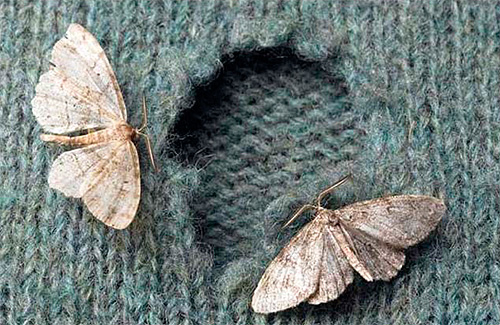
Moth is not only a pest of clothes and carpets. In the family of these butterflies there are "gourmets" who specialize in a wide variety of food products, and if you collect several copies of what the moth eats in one place, a huge hangar will not be enough.
The menu of moths of different types includes a wide variety of foods: cereals, flour, bread, fruits and vegetables, textiles, wool and feathers of almost any animal, and even wax and ant larvae.
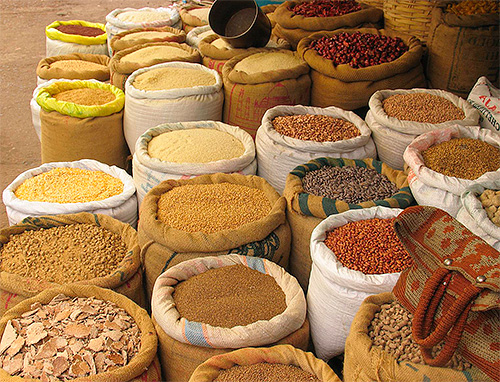
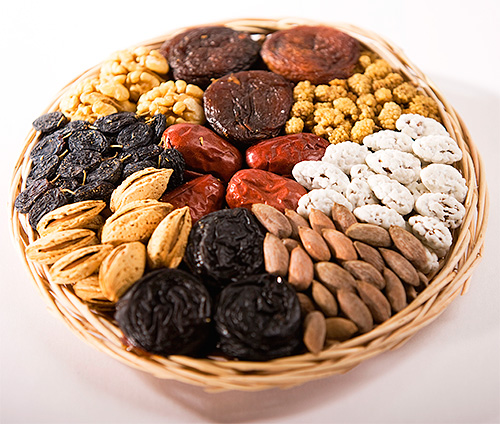

If we talk about butterflies inhabiting home wardrobes, then we can say simply: the moth feeds on any fabrics containing natural raw materials (wool, feathers, cotton, linen, etc.). This is her specialization, inherited from wild ancestors, and such uniqueness in food makes clothes moth a very dangerous pest of our apartments.
Moth and its diet
Moth is not at all a product of civilization and light industry. All types of moths that harm clothes in closets, carpets on the wall and furniture upholstery are not only not limited to the walls of human habitation, but also actively live and thrive in nature.
Clothes moth outside apartments and houses lays eggs in the nests of birds and rodents. Here, moth larvae feed on wool or feathers shed from nest owners.However, such a diet is very scarce, and the constant change in temperature does not allow butterflies to multiply at too high a rate - they have to spend the winter in the form of a chrysalis.
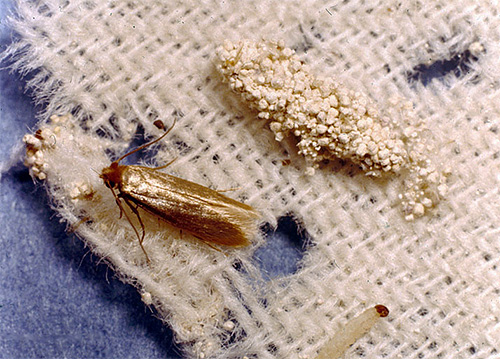
Another moth harmful to humans - food - feeds on seeds and nuts in nature. She can also eat stocks of rodents and ants. It is no wonder that in nature these types of moths are tied precisely to the steppe and forest-steppe zone, where a large number of animals and insects are found, making reserves for the winter.
It is interesting
The food moth does not eat clothes, and if butterflies flying out of cereals or flour appear in large quantities in the kitchen, you don’t have to worry about the closet with linen. Food moth eats only cereals, dried fruits, nuts, flour, sugar, dry bread - foods that people eat.
Once in a human dwelling, the moth did not change its habits. Only here, instead of randomly shedding hair and feathers, “endless fields” of wool, fur and cotton fabric, no less nutritious and tasty, stretched out in front of her.
Getting on a shelf with fur, the moth eats a fur coat, carefully trimming the hairs, grinding them and swallowing them. When she needs to move, but she is not hungry, the larva simply cuts off the hair on her fur coat, but does not eat them, leaving a neat path in the way of her movement. Once in the closet with woolen things, the moth eats wool in much the same way as it gnawed it in the steppes in the burrows of marmots.
In the photo below, the moth larva eats hairs on a fur coat:
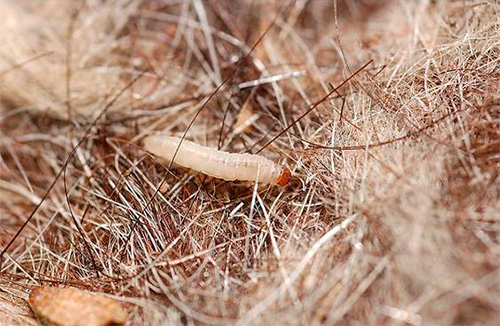
Other types of moth parasitize on textiles and furniture, the larvae of which are adapted to eating just such specific feeds.It is characteristic that all moth larvae are distinguished by their tendency to weave silk cases. In some species, these covers are simple and thin, in others they are carefully made and very durable.
On a note
Clothes and food are eaten only by moth larvae. Adult butterflies are not able to eat or gnaw anything - they do not have developed not only the mouth apparatus, but also the digestive organs. The task of adult butterflies is to reproduce.
The moth eats clothes randomly and does not have any particular favorite areas and places. Holes in a sweater or streaks in a fur coat may appear in unexpected places and in numbers that depend only on the number of larvae in infested clothing.

But if the clothes moth harms clothes rather slowly, then the food moth multiplies indoors at an accelerated pace: its diet is more nutritious, and its larvae grow and pupate faster. Accordingly, the cycle from butterfly to butterfly, from caterpillar to caterpillar, can occur in food moths in 3-4 months, while in clothes moths this process takes at least six months.
Man's constant companion
A human dwelling is much more attractive to moths than any natural biotopes. There are three important reasons for this:
- in human housing there is always a lot of easily accessible food
- in a house or apartment, a constant and optimal microclimate is constantly maintained for almost all types of moths
- in human dwellings, there are practically no natural enemies of moths.
Moth eggs, larvae and pupae develop best at temperatures between 23-25°C. At the same temperatures, a person also feels comfortable. Not surprisingly, this butterfly always prefers to be a roommate of a person.Insects do not even need to fall into hibernation in the form of a chrysalis: they dressed in a cap, pupated, turned into a butterfly in a few days and proceeded to further reproduction.
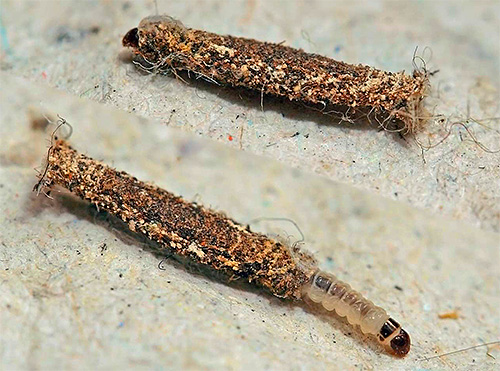
In such comfortable conditions, moths can even get by on less attractive and nutritious food than what they are used to consuming in the wild.
How moth damages clothes
There are known facts that the moth "beats" even synthetic clothes. Before considering this as nonsense, you should first carefully study the composition of the synthetics itself.
Even moths will not eat pure synthetics - the larva is not able to digest nylon or, for example, polypropylene fibers. However, if the thing is made from a mixture of synthetic and natural materials (which people still call "synthetics"), the larva will be quite content with the nutrients from such a product.
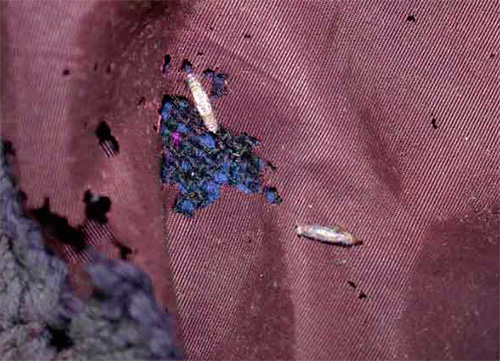
It is interesting
Some synthetic materials in the caterpillar's stomach are not digested, but safely pass through the digestive tract. The more synthetics in the tissue eaten by the caterpillar, the less nutrients the larva itself receives, the slower it grows. Accordingly, on modern “bread”, the development cycle of moths, even under conditions of optimal temperatures, can stretch for almost half a year.
Review
“What to do with this muck. A natural woolen sweater hung on a trempel, hand-knitted - but no, the moth beat through and through the “Sport” cockerel hat, completely synthetic.
Oleg, Kurgan
The moth larva that emerged from the egg does not particularly tend to move away from the place of appearance. Usually she eats away as much tissue or wool around her as possible, sheds several times and pupates here.The cover around her body, especially dense, is even more conducive to this lifestyle.
But sometimes caterpillars, especially young ones, move within the closet at distances large enough for themselves, moving from newly acquired things to those that have already hung. Therefore, it is necessary to destroy the moth either on the outskirts of the closet, or at the first sign of its appearance.
Destruction of pests in cabinets
The main symptoms of a wardrobe infestation with moths are the following:
- incomprehensible nature of damage to clothing
- small pieces of cobwebs on clothes and closet walls
- moth butterflies, and not only in the closet, but also in the apartment in general.
No matter what the housewives who have become proficient in entomology say, it is necessary to destroy the mole in all its forms and stages. Even a butterfly flying around the room, although it does not eat clothes, but participates in reproduction. And consequently, it will give the owner of the cabinet from several tens to several hundred larvae.
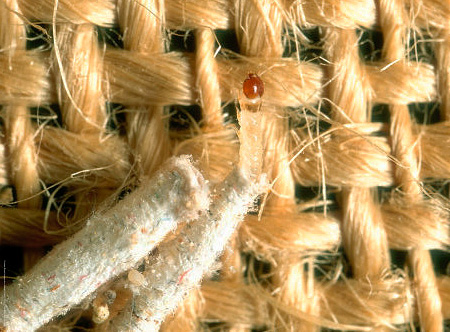
Butterflies are easiest to kill by hand - they are not numerous. Larvae can be destroyed in several ways:
- diligently shaking out clothes
- roasting things in the sun
- washing clothes at a water temperature above 50 ° C
- treatment of both clothing and wardrobe with insecticidal aerosols.
It is important to understand that it is possible to scare away moths with lavender, sections, orange peels or soap only after the larvae and butterflies that already live in the closet have been destroyed. Caterpillars, on the other hand, cannot be scared away by such means - they have nowhere to run - but they can leave their descendants resistant to such repellents.
Protecting clothing from moths
To protect things from moths, there are a large number of means:
- special sections with repellent scents
- essential oils
- crushed lavender flowers
- orange peels
- laundry or strawberry soap, pieces of which are laid out in the corners of the closet and pockets of clothing
- tobacco
…and many other means.
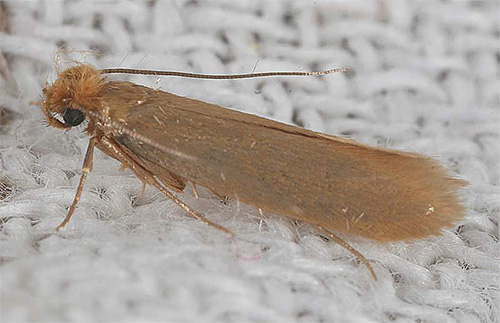
It is important to understand that their effectiveness is not very high. If the moth was brought into a protected closet with clothes, she would have no choice but to endure the smell and continue to live and eat. Therefore, the best way to protect clothes from moths is to directly destroy insects and carefully check and process the items you buy.
Interesting facts about moths: does it have a mouth?

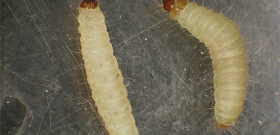

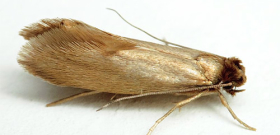
I have a question about moths: how can I remove moths in other ways?
Can be burned along with the cabinet. Radically, but simply. You can move and forget about it until, due to old bad habits, another moth, in a new place, finds its way into your closet.
What nonsense about moths.It seems like the imago does not have an apparatus for eating clothes) But the caterpillars eat, both indoor and domestic, they are also fur coats. All bristles are trimmed, even if they do not eat))
Man-made and synthetic fibers are different things.
Can moths eat leather clothing?
Do moths eat artificial leather?